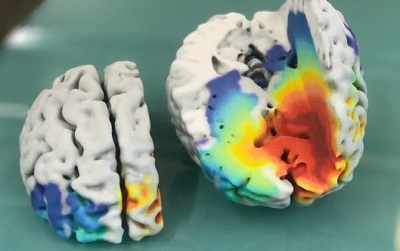Augmented reality headset gives surgeons “x-ray vision” during procedures for
accurate and personalized implant placement while keeping their eyes on their patients

October 20, 2020 – Renowned Spine Surgeon Michael Wang, M.D. professor of neurological surgery and chief of neurosurgery at UHealth Tower—the flagship hospital of the University of Miami Health System–has performed a spinal surgery using special goggles with augmented reality (AR) technology that provides surgeons with 3-D, x-ray vision.
The Augmedics xvision Spine System is used at select medical institutions around the U.S. Dr. Wang performed Florida’s first surgery with the technology on Friday, October 16. The surgery was also the first performed with the equipment in the Southeast U.S.
The groundbreaking augmented reality guidance system allows surgeons to see through a patient’s anatomy as if they have x-ray vision. The xvision Spine System is the first AR guidance system to be used in surgery and is currently approved for use in open and minimally invasive spine implant procedures.
With previous surgical procedures neurosurgeons have had to look at the patient’s anatomy on a distant screen in the operating room. Dr. Wang’s first case using the AR system was a complex scoliosis case on a 72-year-old woman from Miami-Dade County.
“It was the perfect kind of case to use the AR technology because it requires extra precision and finesse for screw placement,” said. Dr. Wang. “The technology is another promising tool that UHealth offers to advance recovery after spinal surgery. The xray vision allows us to see inside the anatomy and makes the surgical area three-dimensional—all of which helps with accuracy during surgery,” said Dr. Wang.
Similar to a real-time GPS, the technology guides spinal surgeons on exactly where to place implants, screws, cages or other devices.
The xvision Spine System consists of a transparent heads-up near-eye-display headset and adds all the elements of a traditional navigation system. It’s designed to determine the position of surgical tools, in real-time, and superimposes them on the patient’s CT data. The navigation data is then projected onto the surgeon’s retina using the headset, allowing surgeons to simultaneously look at both the patient and the navigation data.
Dr. Wang said the technology helps eliminate or greatly lessen the need for surgical teams to perform x-rays during surgery—a practice they relied on to help ensure that screws and other equipment were properly placed.
Dr. Wang, a top neurosurgeon who continues to provide innovative solutions to spine patients in Florida, said that the augmented reality technology can be used with all types of spinal surgeries.
“Used in tandem with UHealth’s wide range of advanced technology, we are encouraged that the augmented reality will help the UHealth spinal surgery team perform procedures with greater ease, control and precision, and that should also lead to better and safer outcomes for patients,” said Wang.



























